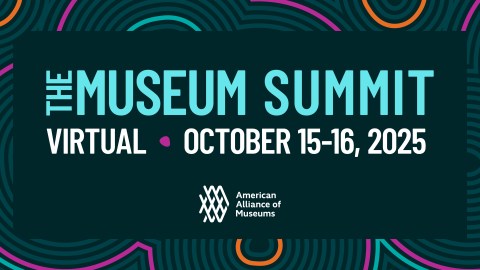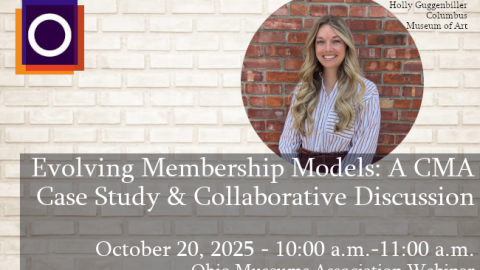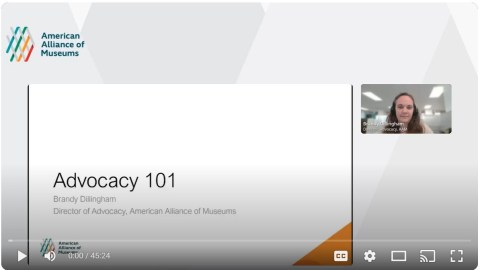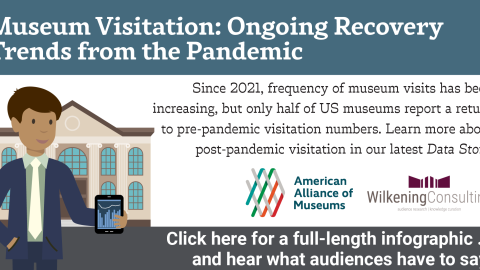
I began writing and speaking about the need for trauma-informed practices in museums several years ago, and while I haven’t seen any big changes in the time since, I have seen small shifts happening that make me hopeful. I’m noticing more people within institutions expressing an interest in trauma-informed practices, particularly those designing and leading programs, working on inclusive interpretation, or welcoming in school groups. And yet there is so much more work to be done.
One small step we can take toward being more trauma-responsive is flagging content that is of a sensitive nature with content warnings. But currently museums are doing this inconsistently if at all, and this seems to be partly a matter of hesitancy or uncertainty about the practice. This phenomenon is not unique to museums—content warnings are a debated point of conversation in many different settings, including education, film, and theater.
To get to the bottom of these debates, and advocate that we take a proactive approach, I want to explain what content warnings are, dispel some of the misconceptions I hear about them, and share some best practices and helpful resources I’ve come across for implementing them.
What Are Content Warnings?
Content warnings are clear written or verbal statements made prior to someone experiencing potentially disturbing content, whether an exhibition, a film, a stage production, or anything else. They are also known as advance warnings, and are sometimes used interchangeably with trigger warnings, but there are nuances between the terms. A trigger warning is a specific type of content warning, often with more precise language than a content warning, that recognizes that some content may cause intense psychological and/or physiological symptoms for people with post-traumatic stress disorder (PTSD), complex PTSD, and other experiences of trauma, anxiety, or sensory sensitivities. For the purposes of this article, I’m going to focus on the wider umbrella term of content warnings.
Content warnings are a way of welcoming people in and ensuring that they feel a sense of safety. When a person feels unsafe—when they are triggered, retraumatized, or shocked in some way beyond their capacity—their prefrontal cortex goes offline. They can’t learn, question, think, create, or connect if their nervous system is overwhelmed or if they are experiencing trauma responses like fight, flight, freeze, fawn, or flop. When museums provide content warnings, are thoughtful about where objects are installed, and provide appropriate framing and resources, we enable visitors to engage within their window of presence so that they can experience what the museum has to offer.
Letting people know what to expect from content of a sensitive nature gives them information so they can make a choice. When someone is given advance notice, they can decide if a particular experience is for them or not. In some cases they might even decide not to opt out entirely, but to participate on a different day or with the right support and preparation. Think about your own life experiences and times when maybe you needed to watch or read something lighter, or had to take a break from the news for your mental health, or perhaps experienced the loss of a loved one and didn’t have the capacity to take in emotionally charged content.
There are several subject areas that warrant giving people advance notice, such as gun violence, racial violence, self-harm, domestic abuse, graphic sexual imagery, loud noises, strobe lighting, and more. (Please refer to the list at the end of this article for a more robust set of topics and sensory inputs.) Someone dealing with substance abuse might be further harmed by seeing content depicting drug use, someone with an eating disorder could be triggered by seeing emaciated bodies or behaviors like purging, and someone who has experienced suicidal ideation or the suicide of a loved one could be overwhelmed by content related to suicide. Content warnings can also help caregivers make decisions around what is age-appropriate for the children they are visiting with.
Arguments Against Content Warnings
In discussing content warnings with colleagues, I’ve found that some people very clearly understand the need for them, while others are dismissive of them. I’ve tried my best to unpack the arguments and rationale people use in the latter cases, so I can understand where the objections are coming from and better convey why they’re a crucial responsibility. Here are some of the common arguments I hear and the holes I see in them:
1. “Content warnings are too expansive.”
One of the reasons people often give for not wanting to include a content warning has to do with the breadth of potential triggers. For example, a person may say “triggers can be anything, so it’s pointless to provide a content warning.” While it’s true that triggers can be anything (e.g., smells, textures, tastes, imagery, sounds, emotional states, sensations, phrases or tones, certain interpersonal interactions, and more), there is some material that is more widely sensitive in nature and likely to trigger people based on their lived experience. Our inability to account for every single trigger doesn’t mean we can’t account for many of them.
2. “Content warnings prevent healing.”
Another argument people make is that if people avoid their triggers, they will never learn to cope or heal from their trauma. While recovering from trauma does sometimes involve learning to identify triggers and reduce the impact they have, that’s something an individual should be allowed to work on and navigate at their own pace, ideally with the support of a trauma therapist or someone else trusted in their life. I don’t think museums or any other public institutions should have the attitude that forgoing content warnings will somehow help people develop a more resilient nervous system. To me, this sounds less like genuine concern than shaming trauma survivors for being “too sensitive,” which I find particularly offensive knowing so many of us who are incredibly strong and compassionate. You are not “coddling” someone by providing a content warning; you are demonstrating that you have compassion and empathy for their life, history, and struggles.
3. “Content warnings make anxiety worse.”
There are also people who point to studies saying that content warnings make someone experience anticipatory anxiety, stirring up a reaction before they have even encountered the content. I think there are a couple of issues with this argument.
First, if someone is feeling anxious over a content warning, it’s likely because they have underlying trauma or experiences that do put them at risk for being triggered by the material. A traumatized nervous system will make someone feel more hypervigilant, possibly increasing feelings of anxiety, panic, or overwhelm. If reading a content warning causes someone to feel this way, imagine what might happen if they encountered the material without advance warning.
Second, even if it is true that a content warning causes a startle sensation, that response can be a helpful cue for the visitor. Based on their reaction, they can decide whether to 1) follow through on engaging in the exhibition, feeling more prepared than if there was no content warning, or 2) opt out, feeling they were given enough information to make the right choice for themselves in that moment. Moving through a response like this can help build resilience.
Another issue with the argument that content warnings make people anxious is that people are often referring to general content warnings, which are not best practice to begin with. It is true that content warning that is too broad can potentially create more anxiety than necessary, because a person is left guessing about what they might face. For example, saying “this exhibition contains violent imagery” is very different from saying “this exhibition contains imagery of interpersonal violence and discussion of domestic abuse.”
4. “Content warnings are a form of censorship.”
At many museums there are debates, and sometimes clashes, over where to position certain objects. For example, a museum might be planning to hang a work of art that depicts racial violence, and a few staff feel strongly that it should be positioned in the lobby or some busy interstitial area, perhaps with the thinking that the work is so powerful they want all visitors to see it, or that they want to communicate loudly that this is one of the topics they are addressing at the museum. When other staff advocate for the work being positioned somewhere more discreet because of its traumatic content, these staff members might fire back, calling that censorship.
Being trauma-informed is not about censorship; it’s about thinking about neurobiology and considering all nervous systems with care and compassion. Jarring objects in lobbies or interstitial places do not give people a chance to get oriented to the museum, nor do they give people a choice to bypass seeing them. What if you are a Black teen visiting an art museum for the first time with your school and you have lived experience of being attacked because of the color of your skin and one of the first things you encounter is a large painting depicting people that look like you being attacked? Or if you are a survivor of rape and you go to an art museum as part of a social prescription program, only to encounter a work depicting rape that you can’t avoid and weren’t given any notice about?
This is not to say that museums should not be showing such works at all, but that the right context is important, both for the visitor and for the work itself. Works that are activating or have challenging material need to be properly witnessed. They deserve the right setting and framing to fully support visitors in giving them the time and attention they require. A visitor can’t acknowledge their own internal reactions to a work, notice and name emotions and bodily sensations, and reflect on what’s before them in a space that isn’t set up to allow for that. It doesn’t do justice to the object or its maker to position it in a space where visitors can’t even sit and hear their own thoughts, where there are multiple things happening that don’t involve contemplating meaning (e.g., ticket scanning, information desks, and elevator banks). Following trauma-informed guidelines doesn’t take away a work’s provocation or power; if anything, it supports them by reducing the chances of someone becoming emotionally flooded and thus unable to engage.
5. “Content warnings take away from the experience.”
I once read an article in The Guardian where Sir Ian McKellen said he was against content warnings, because he felt that theater was meant to shock and giving people advance information ruined this experience. I completely disagree, whether we are talking about the theater, films, or museums. For one thing, it’s very easy for people who don’t need content warnings to skip over them, if they prefer. They are there for people who do need them, the same way physical accommodations are there for people who need them.
One of the best content warnings I’ve read ever was for Jagged Little Pill: The Musical. It read:
“Age recommendation of 14+. Please note: This production contains strong language, adult themes, drug use, and moments of sexual violence that some may find triggering. Jagged Little Pill addresses many topics of contemporary life, including sexual assault, opiate addiction, transracial adoption, gender and LGBTQIA+ identity, marriage struggles, and mental health.”
The warning also highlighted the use of strobe lights, haze, and strobing video effects, and provided additional information and resources for those who wanted them. For me, this warning did not lessen the impact of this production at all. I felt every ounce of that production in my body and experienced a range of emotions, but I knew what I was getting into, so that I was able to stay present throughout the performance even though some of my past trauma paralleled what took place on the stage. For some people with unprocessed or fresh trauma taking in this production might be too much, but thanks to the content warning they can make that decision for themselves.
Rather than taking away from the experience, content warnings build trust between the audience and the institution. By consistently providing content warnings that follow best practices, museums are communicating to visitors and staff that they are reliable and trustworthy. On the flipside, when they do not provide them, or haphazardly provide them based on the whims of different staff persons, or provide them only after a visitor complains, their trustworthiness plummets. To truly show care, we must take a proactive rather than reactive approach.
Content Warning Best Practices
A content warning should be as specific as possible.
Think about advisories that you’ve seen on film or tv series that were too general, saying something like, “This film contains nudity, strong language, and violence.” That doesn’t really tell a person much, besides perhaps determining age-appropriateness. For example, based on their lived experience, a person might be able to watch a movie with some forms of violence (such as battle scenes with swords), but not other kinds (such as depictions of bombings in war). A helpful content warning would say something like: “This section of the exhibition contains discussion of sexual assault and suicide, along with drawings that depict self-harm,” or, “This gallery space includes a sound installation of sirens that sound for thirty seconds every seven minutes, as well as periods of dimmed lighting during the thirty seconds the sirens are sounding.”
Give visitors the information; don’t tell them what to do or how to feel.
Everyone is different, and different things may help someone at different times. A museum can’t make blanket recommendations of how someone should experience an object or a particular space or program, because there’s no guarantee how someone will experience something. Museum visitors are not monolithic. We shouldn’t edge someone into trying something they might have reservations about trying.
Provide content warnings in the right place and at the right time.
If a particular exhibition or gallery contains content of a sensitive nature, let people know before they’ve entered the space. Be clear about whether it’s the entire exhibition or gallery, or one section of it. If it’s one section, share if there’s any way to bypass that section or not. For example, “The third gallery in this exhibition contains pornographic imagery. If you would like to skip this portion of the exhibition, you will need to pass through the space.” Another content warning sign should appear in the gallery or section of the gallery with the sensitive content to help cue visitors.
Ensure the content warning is highly visible.
Don’t bury a content warning at the end of an introductory text wall or a web page of an exhibition. Provide the information in multiple spots and in highly visible locations so that visitors have easy access to it.
Don’t add additional information to a content warning sign.
Messaging on a content warning sign should be focused. Adding additional text such as “please do not touch the art” diverts focus from key decision-making information.
Don’t make assumptions about how someone will experience something.
While experiences at museums can feel therapeutic to some people, this isn’t true for everyone. A museum might assume, for example, that a mindfulness program it offerd is soothing for all and therefore fail to build in trauma-informed supports. While it can be helpful to remind people attending a program that they are free to leave when they want, please remember that if someone hasn’t been given proper advance warning about something potentially activating and they end up getting triggered they might not be able to leave even if they want to. Sometimes when trauma is triggered a person might freeze and feel unable to escape what their body and mind is registering as dangerous.
Don’t call out specific diagnoses or groups of people.
For example, saying “this gallery contains audio of screaming that plays every five minutes. Visitors who have PTSD or autism might find this overwhelming, so please use discretion.” Every person is different, so the museum shouldn’t make assumptions that all people with PTSD or autism will find something overwhelming. This approach can also make people with these diagnoses feel othered or unwelcomed, instead of normalizing their needs.
There can be exceptions to this, such as the content warning I wrote for Guadalupe Maravilla’s Healing Sound Baths installation and audio playlist at MoMA. It reads: “Sound Baths can be soothing and healing for some nervous systems, but not all. If you are sensitive to sensory stimuli or have unprocessed trauma, the experience might bring up unexpected emotions, sensations, physical responses, and/or disorientation. Go at your own pace and check in with yourself. If you notice yourself beginning to feel overwhelmed or feel dissociated, it’s a good idea to stop listening and take steps to get grounded.” In this case, it felt important to give people a heads up that the experience can bring unprocessed trauma to the surface before someone is ready to deal with it, because of my own past experiences being overwhelmed by yoga and meditation.
Consider staff too.
For trauma-informed practices to really be folded in museum culture, we need to also think about how all this applies to staff as well as visitors. I think a lot about Andrea Montiel de Shuman’s article “No Longer in Extremis” from 2020, where she wrote about her experiences having her trauma and advocacy for trauma-informed interpretation dismissed in the museum workplace. I’ve been in meetings where the conversation centered on a work of art about trauma matching my own, and experienced that horrible feeling of being sucked back in time, powerless and frozen and unable to make it stop. I’ve also witnessed other colleagues become triggered during meetings and end up in the place of trying to both advocate and take care of themselves. It happens far too often. I’ve heard colleagues express that they want to feel safe—safe to share their opinions on important matters, safe to be in community with one another, and safe so that they can do their jobs to the best of their ability. But how can people feel safe, from a nervous system point of view, if they aren’t being given context and choice? Meetings, just as much as an exhibition, sometimes need a content warning. And everyone should have a choice about how they want to engage or opt out of an experience.
A (non-exhaustive) list of where content warnings can be helpful:
Subject matter
- Ableism
- Abortion
- Abuse (e.g., sexual, physical, and/or emotional abuse, domestic abuse, childhood abuse, incest)
- Adoption (e.g., interracial adoption, abandoned by birth parents)
- Animal cruelty or death
- Blood
- Bullying
- Classism
- Death, dying, or grieving (e.g., parental loss, death of a child, death due to violent accident or war)
- Eating disorders (food restriction, emaciated bodies, purging, body checking, binge eating, fatphobia, body shaming, diet talk, body loathing, exercise addiction)
- Explicit language
- Foster care
- Gambling
- Gun violence (e.g., armed invasions)
- Hoarding
- Homophobia and heterosexism
- Immigration, migration, or displacement
- Incarceration
- Institutionalization (e.g., inpatient treatment for mental illness)
- Isolation and loneliness
- Kidnapping, stalking, or abduction
- Marital struggles, divorce, or custody battles
- Medical procedures, injuries, or trauma
- Mental illness
- Miscarriages
- Natural disasters, fire, or climate crisis
- Neglect
- Police brutality
- Poverty, food scarcity, or housing insecurity
- Pregnancy, childbirth, or infertility
- Racism, racial violence, or racial slurs
- Religious hatred (e.g., antisemitism and Islamophobia)
- School shootings
- Self-harm
- Sexism and misogyny
- Sexual assault or rape
- Sexual content (e.g., sex workers, sex trafficking, pornography)
- Slavery or servitude
- Substance abuse
- Suicide or suicidal ideation
- Transphobia and transmisogyny
- Violence (e.g., murder, torture)
- War (e.g., bombing, hostages)
Sensory inputs
- Audience participation or interaction
- Bright lights or extreme lighting design
- Cavernous spaces
- Darkness
- Fog or mists
- Foods with known allergens
- Hazy lights or atmosphere
- Intense or sudden changes in light levels
- Jarring sounds (e.g., sirens or doors slamming)
- Loud sounds, changes in volume, high-pitched tones, intense bass, or shouting/screaming
- Mirrored spaces
- Overlapping sounds
- Scents and fragrances
- Sound baths
- Strobe lights, strobing videos, or flashing lights
- Temperatures (e.g., overly hot or cold conditions, cold wind/blowing)
- Textures in interactive installations (slimy, sticky, etc.)
- Tight spaces, low ceilings
- Uncomfortable seating (seats without backs, hard seats, sloped seats, seating that is too low)
- Uneven floors
- Vast open spaces, spaces with glass partitions, or elevated perspectives (e.g., bridges overlooking open spaces)
- Vibrations









Thanks for this excellent blog post, Jackie! We’ve had a small number of visitors tell us we should have content warnings for what I would call inclusive content (LGBTQ+ history and imagery) – so not any of the categories you list above, and sometimes they add they would like the warning so they can shield their children from that subject. Is any content that might cause discomfort worthy of a content warning? Do you have advice for dealing with this type of suggestion/request?